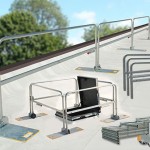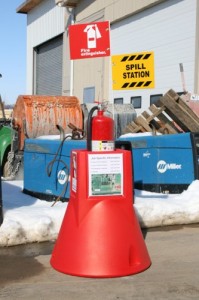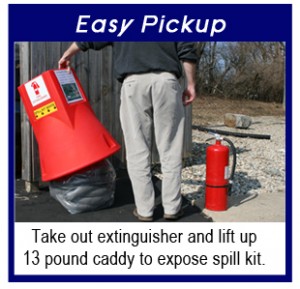Effective August 1, 2016; OSHA will increase the max fine amount from $70,000 to $124,000 for willful (knowing the law but ignoring it) and repeat violations. You know the law – do not fail to train your crew.
Category Archives: 30 hr osha
Roof Guard Rail System
 When employees are required to do maintenance on the heating and cooling equipment located on the roof they must be protected from falls. The solution must comply with OSHA (Standards-29CFR) 1910.23 and 1926.502. The simplest way to do this is with a roof guard rail system that is easy to install, requiring no tools and does not damage the roof. Roof Zone has developed a product, the RZ Guardrail System, that meets these requirements. Made in the USA, it’s the quickest and easiest guardrail system to install and remove, requiring no tools, no permanent installation, and galvanized to eliminate rust issues.
When employees are required to do maintenance on the heating and cooling equipment located on the roof they must be protected from falls. The solution must comply with OSHA (Standards-29CFR) 1910.23 and 1926.502. The simplest way to do this is with a roof guard rail system that is easy to install, requiring no tools and does not damage the roof. Roof Zone has developed a product, the RZ Guardrail System, that meets these requirements. Made in the USA, it’s the quickest and easiest guardrail system to install and remove, requiring no tools, no permanent installation, and galvanized to eliminate rust issues.
The guardrail base mount is hot-dipped galvanized with protective protective vinyl pads attached to protect roof. The base holds two rails and comes with easy grip openings on each for one or two persons to carry. Optional toe board brackets are available. The galvanized guard rail are available in 6 ft., 8 ft. and 10 ft. length. For roof hatch or skylight applications, a swing gate guardrail is available.
For applications where it is required to maintain sight lines while offering fall protection an optional collapsible guardrail bracket is available so the guard rail system can be laid down on the roof to maintain architectural integrity.
Please visit our website for more info or call us at 800-776-3595 for more information.
OSHA Job Site Safety
This summer OSHA is promoting two new job site safety programs. The first is OSHA’s National Stand Down. The week of June 2nd thru 6th will be their week to raise awareness of preventing fall hazards in construction. In 2012, 269 construction worker fatalities out of a total 775 were caused by falls. Many of those deaths were preventable by proper job planning and instruction. Fall prevention safety standards were among the top 10 most frequently cited OSHA standards, during fiscal year 2012. Here is a link to planning a step down program for your organization.
In conjunction with this program they are concurrently promoting OSHA’s Plan, Provide, Train program. Using OSHA’s three simple step program, many job related falls can be prevented. OSHA’s website is part of a nationwide outreach campaign to raise awareness among workers and employers about the hazards of falls from ladders, scaffolds and roofs. Plan ahead to get the job done safely. Provide the right equipment equipment. Train everyone to use the safety equipment safely. Three simple steps that save lives.
Safety Pays, but Falls Cost
Here is a copy of an article I found written by Jim Maddux, director of OSHA Directorate of Construction. Take a few minutes to read it.
Safety Pays, but Falls Cost
OSHA’s Fall Prevention Campaign promotes ‘Planning,’ ‘Providing’ and ‘training’ to reduce the number one cause of death in construction
By Jim Maddux, director, OSHA Directorate of Construction
Falls account for one third of all work-related deaths in the construction industry. In 2010, there were 264 fall fatalities (255 falls to lower level) out of 774 total fatalities in construction. Of those deaths from falls, 90 were from roofs, 68 from ladders and 37 from scaffolds.
Many of the workers who are killed and injured on the job are temporary workers who perform the most dangerous jobs and often have limited English proficiency, and who don’t always get the training and equipment they need to do their jobs safely. As Assistant Secretary of Labor for Occupational Safety and Health Dr. David Michaels has said, “All workers have the right to go home safe and sound at the end of the day, whether they’ve been on the job one day or 25 years.” Continue reading
Construction Rises to the Top Spot in Labor Statistics’ Deadliest Industries List
 Fatal work injuries in the private construction sector increased 5 percent to 775 in 2012, while total hours worked in the industry increased just one percent.
Fatal work injuries in the private construction sector increased 5 percent to 775 in 2012, while total hours worked in the industry increased just one percent.
The 2012 increase in fatal occupational injuries follows five consecutive years of declining fatalities in construction. Fatal construction injuries are down 37 percent since 2006.
The reversal in construction’s worker-fatality trend is stark in light of the fact that the 2012 fatal-work-injury count for all U.S. employers is down 6.6 percent to the second-lowest total since the U.S. Bureau of Labor Statistics first started conducting the Census of Fatal Occupational Injuries in 1992
The rate of fatal work injury for all U.S. workers in 2012 was 3.2 per 100,000 full-time equivalent workers, down from a rate of 3.5 per 100,000 in 2011. There were 9.5 U.S. construction-worker deaths in 2012 per 100,000 full-time workers.
How much does a jobsite injury really cost?
I recently can across a very interesting tool to help you to realize how much does a jobsite injury cost you. Employers can use the” $afety Pays” to assess the impact of occupational injuries and illnesses on their profitability. This program uses a company’s profit margin, the average costs of an injury or illness, and an indirect cost multiplier to project the amount of sales a company would need to generate to cover those costs. The program is intended as a tool to raise awareness of how occupational injuries and illnesses can impact a company’s profitability, not to provide a detailed analysis of a particular company’s occupational injury and illness costs. Your local OSHA On-site Consultation Office can help small businesses identify workplace hazards and develop and implement an effective injury and illness prevention program. This tool is part of the OSHA Small Business program that provides links to numerous OSHA resources and information designed specifically for small business employers, including safety and health tools and publications, easy-to-follow guides for specific OSHA standards, and descriptions of benefits that small businesses receive from OSHA. The page also includes information on the Safety and Health Achievement Recognition Program (SHARP), which recognizes small business employers who operate exemplary injury and illness prevention programs.
OSHA Job Site Fire Safety
 We would like to introduce a new product for the Job Site. OSHA job site fire safety requires that fire extinguishers be properly identified, be easy to locate and have the proper identification. Our new product Jobsite Caddy fills all these requirements. Jobsite Caddy is designed to support an effective fire protection and spill response program for your job site. This all-inclusive station serves as a fire extinguisher holder, spill response solution, and a hub for job-specific emergency information. It can be ordered base separably, base with extinguisher flag, base with extinguisher and spill station flag and spill kit.
We would like to introduce a new product for the Job Site. OSHA job site fire safety requires that fire extinguishers be properly identified, be easy to locate and have the proper identification. Our new product Jobsite Caddy fills all these requirements. Jobsite Caddy is designed to support an effective fire protection and spill response program for your job site. This all-inclusive station serves as a fire extinguisher holder, spill response solution, and a hub for job-specific emergency information. It can be ordered base separably, base with extinguisher flag, base with extinguisher and spill station flag and spill kit.
OSHA Guide to Scaffold Use in Construction
OSHA’s Safety Standards for Scaffolds publication. This informational booklet is intended to provide a generic, non-exhaustive guide to scaffold use in construction. This publication does not itself alter or determine compliance responsibilities, which are set forth in OSHA standards themselves and the Occupational Safety and Health Act of 1970.
OSHA also has a list of publications covering many other issues that effect business operations. Most of these can be downloaded and used as handouts. They are also offered in different languages.
They also offer links to online training for the OSHA 10 hr, 30 hr. construction courses and also the 10 hr. and 30 hr. general industry course.
Moreover, because interpretations and enforcement policy may change over time, for additional guidance on OSHA compliance requirements, the reader should consult current administrative interpretations and decisions by the Occupational Safety and Health Review Commission and the courts.
Material contained in this publication is in the public domain and may be reproduced, fully or partially, without permission of the Federal Government. Source credit is requested but not required.




